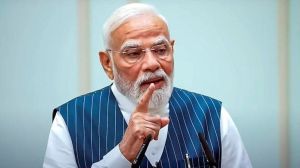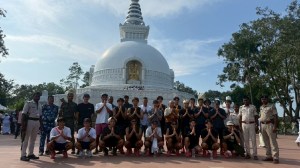26 countries alerted in 15 minutes, India not one of them
After yesterday’s earthquake, there were 90 minutes before the first wave of the deluge crashed into the Indian coast. Within 15 minute...

After yesterday’s earthquake, there were 90 minutes before the first wave of the deluge crashed into the Indian coast. Within 15 minutes of the earthquake, scientists running the tsunami warning system for the Pacific had issued a cautionary from their Honolulu hub, to 26 participating countries. India was not among them.
This tsunami warning stated: ‘‘Revised magnitude based on analysis of mantle waves (8.5). This earthquake is located outside the Pacific. No destructive tsunami threat exists for the Pacific basin…There is the possibility of a tsunami near the epicentre.’’
The last part of this warning was crucial to India, as it was this very ‘‘possible tsunami’’ that ravaged the east coast.
But such was the level of ignorance that even National Institute of Oceanography (NIO) director Satish R Shetye admits: ‘‘I got to know about the tsunami at around 10 am on Sunday, I was completely taken by surprise.’’
The irony could not have been sharper. For, one of the people who helped set up the Pacific Tsunami Warning System and the Canadian Tsunami Warning System three decades ago was a Canada-based Indian, Tad Murty.
Now attached to the University of Manitoba, Winnipeg, Murty says key equipment and computer models could have helped save thousands. He has personally taken up the issue of setting up a 24-hour tsunami warning system with the Indian government.
‘‘I have tried several times with the Indian government, but they have said they do not have enough money to sustain a full-fledged system,’’ Murty told The Indian Express from Manitoba, ‘‘it is largely seen as a Pacific country problem.’’
Immediately after an earthquake, computer models can calculate how fast the waves will travel, as well as their amplitude. Murty has developed computer models for the Indian Ocean on his own initiative. The lack of these is exactly what has the Indian Seismological Central Receiving Station complaining.
According to Murty, in spite of speeds of 400-500 miles per hour, it is possible to make warnings practicable.
The Indian met office has its own explanations. ‘‘Unless we have computer models, we cannot issue a tsunami warning after every earthquake,’’ says R S Dattatrayam, director (seismology), Indian Meteorological Department. Every major earthquake in the ocean does not result in a tsunami.
There was a major earthquake on June 26, 1941, of a magnitude of 8.1 off the coast of the Andamans. But it did not result in any tsunamis, Dattatrayam says: ‘‘It is a question of science. We cannot issue a warning causing panic, unless we can establish it scientifically.’’
But the need for a permanent warning establishment has been voiced earlier: ‘‘With population increasing on the coasts, these systems should have been set up long time ago,’’ says Murty, ‘‘anything more than an earthquake of 6.5 on the Richter scale can trigger a tsunami.’’
As recently as June 2004, a meeting of the Inter-Governmental Oceanographers’ Commission, a UN expert body, concluded, ‘‘The Indian Ocean has a significant threat from both local and distant tsunamis.’’
In Hawaii, the Pacific Tsunami Warning Centre was set up in 1965 and has almost mastered the art of forecasting destructive waves. Its member countries receive specific early warnings with exhaustive data on tsunamis and can bank on an extensive network of seismic stations to locate potentially ‘‘tsunamigenic earthquakes’’ in near real-time.
The system is connected via satellite and telephone to nearly 100 water level stations throughout the Pacific that can be used to verify the generation and possible severity of a tsunami.
India will have to start from scratch. And the official explanation trotted out that yesterday’s tsunami was unique doesn’t quite match the facts.
In the past century itself, Mumbai (then Bombay) was hit by tsunamis on November 28, 1945. These occurred after an earthquake off the Makran coast, Baluchistan, now in Pakistan.
According to the Amateur Seismic Centre (asc-india.org), the quake, which killed 4,000, was severe in Baluchistan. Tsunamis did damage as far as Karachi, Muscat and Iran. Tsunami waves reached a height of 11 m in Kutch, but subsided to two metres by the time Mumbai was hit at 8.15 am.
The last tsunami known to have attacked the Indian mainland from the east occurred on April 2, 1762, only five years after the Battle of Plassey. An earthquake at sea, just off the Arakan coast in Myanmar, shook Chittagong — tremors were said to have been felt as far away as Kolkata — and generated tsunamis that flooded Dhaka, killing 500 people.
The Andaman and Nicobar Islands are no stranger to localised tsunamis. On December 31, 1881, an earthquake off the Andaman Islands led to waves lashing the Coromandel Coast and shattering installations in Port Blair.
On June 26, 1941, the Andaman Islands were hit by the region’s strongest known earthquake. Tsunamis invaded the Bay of Bengal and the Coromandel Coast, inflicting damage on Port Blair. An earthquake off North Andaman also caused tsunamis and killed two people in September 2002.
In the footsteps of ‘‘tsunami’’, a new word waiting to be introduced to the Indian vocabulary is ‘‘seiche’’. Seiches, experts say, are huge movements of water in lakes and reservoirs caused by a knock-on effect following a distant earthquake.
The man who was killed while bathing in a pond in West Bengal’s Nadia district, at about 6.30 am on Sunday morning, probably died in a seiche
The first seiche recorded in India was in 1861, noticed in Kolkata and parts of Bengal and Orissa. Its cause? A massive earthquake in Sumatra, Indonesia, that also threw up monstrous tsunamis!
Photos


- 01
- 02
- 03
- 04
- 05




























